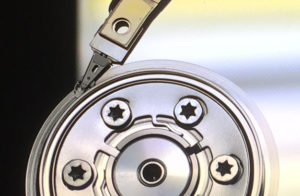
The platters and actuator heads of a hard drive.
The Master Boot Record (MBR) is a boot sector on hard drives or other storage media on PC systems. It includes information about a disc’s partitions, along with an executable code that allows the computer to load the installed operating system (for example, Microsoft Windows).
When a computer starts up, it loads the MBR into memory and executes the code stored in it. This code then loads the operating system into memory and starts it up.
MBRs have been a standard feature of PCs since 1983. However, they’re currently in the process of being replaced by the Global Unique Identifier (GUID) Partition Table (GPT).
Why is GPT replacing MBR?
GPT (GUID Partition Table) is progressively replacing MBR (Master Boot Record) as the standard partitioning scheme for hard drives and other storage devices. This transition is driven by several key advantages that GPT offers over MBR.
- Larger storage capacity: One of the most significant advantages of GPT is its support for drives larger than 2TB. MBR is limited to 2TB because it uses a 32-bit field to store the starting and ending sectors of each partition. GPT, on the other hand, uses a 64-bit field, which allows it to address drives up to 18 exabytes in size.
- More partitions: GPT also allows for more partitions than MBR. MBR only allows for 4 primary partitions or 3 primary partitions and an extended partition, which can be further divided into logical partitions. GPT, on the other hand, allows for up to 128 partitions, which can all be primary partitions.
- Improved data integrity: GPT uses cyclic redundancy checks (CRCs) to protect the partition table from corruption. CRCs are checksums that are calculated for each block of data in the partition table. If a CRC fails, it indicates that the data in that block has been corrupted. GPT can then use the backup copy of the partition table to restore the corrupted data. MBR does not use CRCs, so it is more susceptible to data corruption.
- Support for UEFI: GPT is required for UEFI (Unified Extensible Firmware Interface), which is a modern firmware interface that is replacing BIOS. UEFI provides several advantages over BIOS, including faster boot times, support for larger drives, and improved security.
How does the Master Boot Record affect startup?
The MBR allows the PC to start the operating system, so it’s essential. It consists of a master boot routine, a disk partition table (DPT), and an identification code. Each part is quite small:
- Master Boot Routine – 446 bytes.
- DPT – 64 bytes.
- Identification Code – 2 bytes.
What happens if the Master Boot Record becomes damaged?
You will be unable to boot Windows. You may see an error message that declares your disk “unreadable” or “corrupt.”
On modern PCs, the computer will probably attempt to repair the corrupt MBR — you may be prompted to insert a recovery disc, but the repair process is usually pretty simple.
If the MBR is completely destroyed, is data recoverable?
Yes. In fact, Windows will usually be able to handle the issue automatically — the Startup Repair tool can fix most problems without user intervention.
You can also run the following command from the Command Prompt to manually attempt a repair:
bootrec.exe /fixmbr
You should only attempt manual repair if you’re 100% confident in the source of data loss — a damaged MBR may be an indicator of a more serious issue such as a read/write head failure.
The bottom line: If data is essential, the safest course of action is to contact a professional data recovery provider. You generally get one chance to recover your data; don’t take unnecessary risks.
Related: What Is A Hard Drive Head Crash?
Expert Solutions for HDD Data Recovery
Datarecovery.com provides risk-free evaluations for all hard drive failure scenarios. We support all cases with a no data, no charge guarantee: If we’re unable to recover the files you need, you don’t pay for the attempt.
Call 1-800-237-4200 to speak with a data recovery expert or submit a case online.





